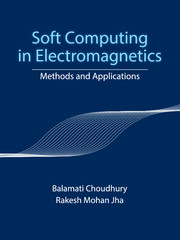Book contents
- Frontmatter
- Dedication
- Contents
- List of Figures
- List of Tables
- Preface
- Acknowledgments
- Abbreviations
- Symbols
- 1 Introduction
- 2 Soft Computing Techniques
- 3 Soft Computing in Electromagnetics: A Review
- 4 Bacterial Foraging Optimization For Metamaterial Antennas
- 5 PSO for Radar Absorbers
- 6 Characterization of Planar Transmission Lines Using ANN
- 7 Fault Detection in Antenna Arrays
- 8 Multi-Objective Particle Swarm Optimization for Active Terahertz Devices
- 9 Soft Computing based CAD Packages for EM Applications
- Author Index
- Subject Index
- References
9 - Soft Computing based CAD Packages for EM Applications
Published online by Cambridge University Press: 05 July 2016
- Frontmatter
- Dedication
- Contents
- List of Figures
- List of Tables
- Preface
- Acknowledgments
- Abbreviations
- Symbols
- 1 Introduction
- 2 Soft Computing Techniques
- 3 Soft Computing in Electromagnetics: A Review
- 4 Bacterial Foraging Optimization For Metamaterial Antennas
- 5 PSO for Radar Absorbers
- 6 Characterization of Planar Transmission Lines Using ANN
- 7 Fault Detection in Antenna Arrays
- 8 Multi-Objective Particle Swarm Optimization for Active Terahertz Devices
- 9 Soft Computing based CAD Packages for EM Applications
- Author Index
- Subject Index
- References
Summary
This chapter covers the use of soft computing for creating various CAD packages. These packages deliver a range of features including efficiency, quick response as well as an easy-to-use user interface that allows even users not well versed with soft computing to arrive at optimized solutions for their applications. In the chapter, the development of two such CAD packages is discussed: one for the design of metamaterial split ring resonators and the other for path loss prediction in rural and urban environments. The CAD package for metamaterial structures uses PSO for design optimization whereas the path loss prediction CAD package uses neural network. Soft computing techniques based CAD package are gaining momentum in the field of electromagnetic (EM) applications because of their properties such as global optimization, quick response and accuracy [Mishra and Patnaik, 1993].
CAD Package for Metamaterial Structures
Metamaterials are artificially designed EM structures that acts as an effective medium with negative refractive index at a desired frequency of operation. Split ring resonators (SRR) are proven metamaterial structures for various applications such as metamaterial based antennas, radar absorbing materials, THz absorbers for biomedical applications, frequency selective surfaces, invisibility cloaks [Kwon et al., 2007; Jin and Samii, 2007; Goudos and Sahalos, 2006; Ivsic et al., 2010], etc. Due to the inherent narrowband operation of the split-ring resonators, it is critical to ensure that the resonant frequency of the same is equal to that of the application.
Therefore, a CAD package is developed here to obtain the optimized structural parameters for different configurations of the metamaterial SRR for a desired frequency of operation. This CAD package uses particle swarm optimization (PSO), which is based on the movement and intelligence of swarms as discussed in Chapter 2, for optimizing difficult multidimensional discontinuous problems. The equivalent circuit analysis (ECA) method is used here as an electromagnetic solution tool for SRR design optimization. Hence PSO in conjunction with ECA method provides optimal structural parameters of the different configurations of SRRs.
Equivalent circuit analysis of square SRR
The analysis of metamaterial structures is carried out using equivalent circuit analysis method where the metamaterial SRR is represented as equivalent circuit of lumped elements. Several metamaterial configurations, such as single ring, double ring, and triple ring square SRR are considered. In addition to these structures, circular SRR is also analyzed.
- Type
- Chapter
- Information
- Soft Computing in ElectromagneticsMethods and Applications, pp. 182 - 204Publisher: Cambridge University PressPrint publication year: 2016



